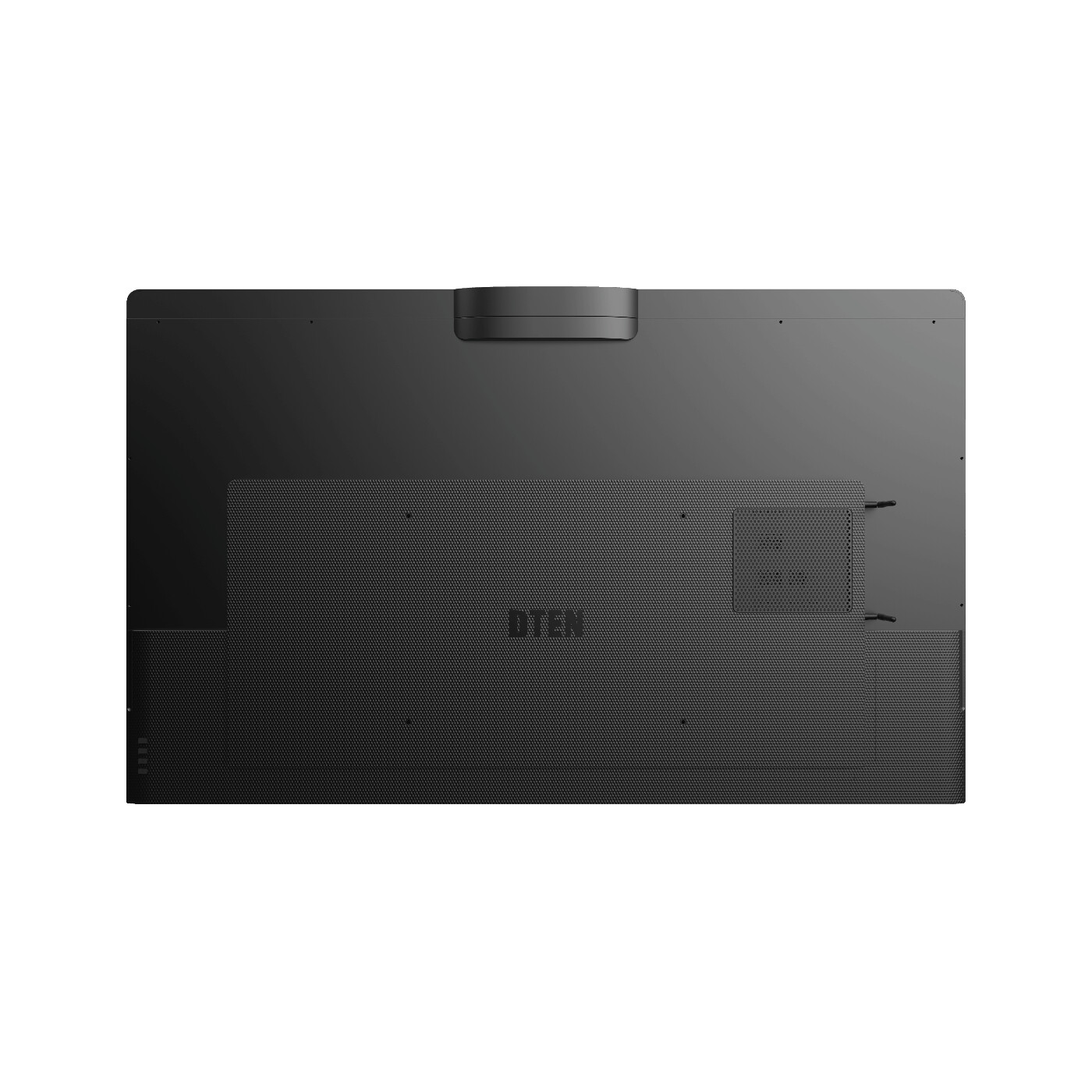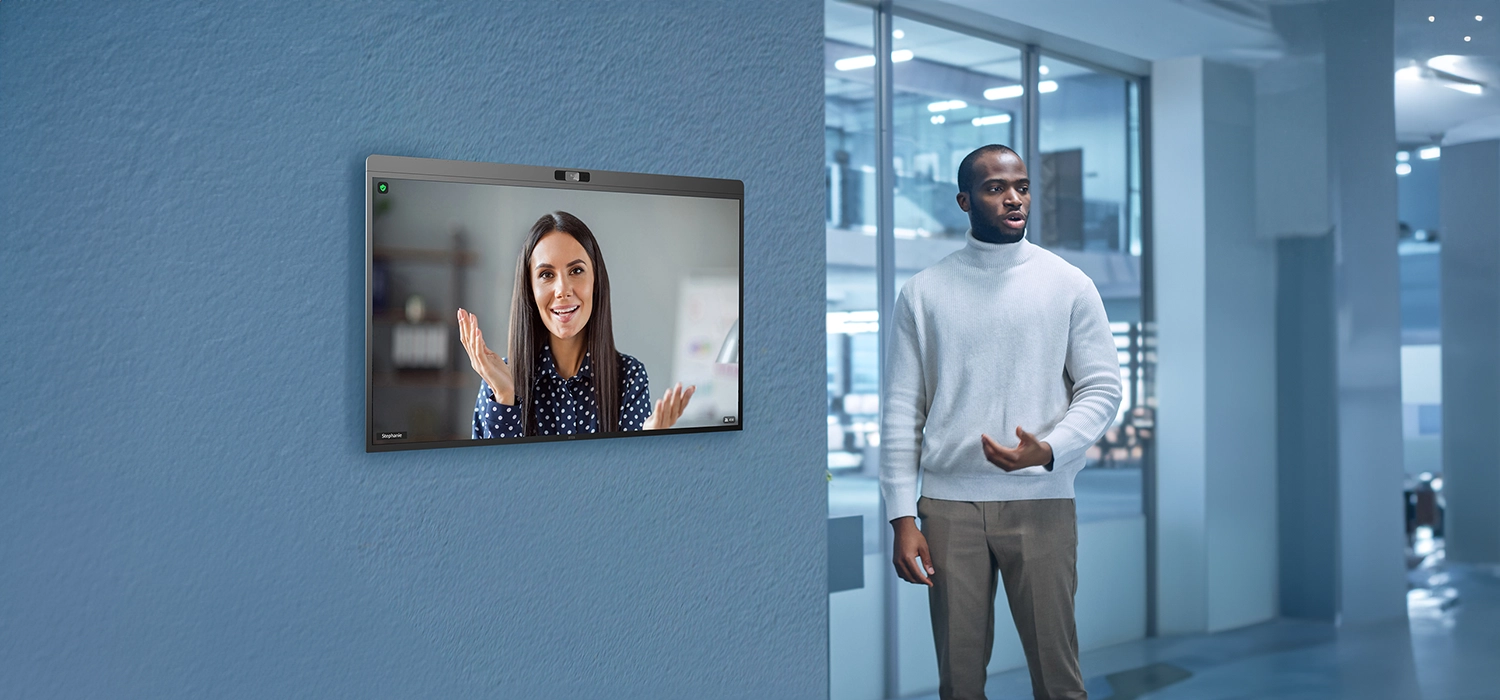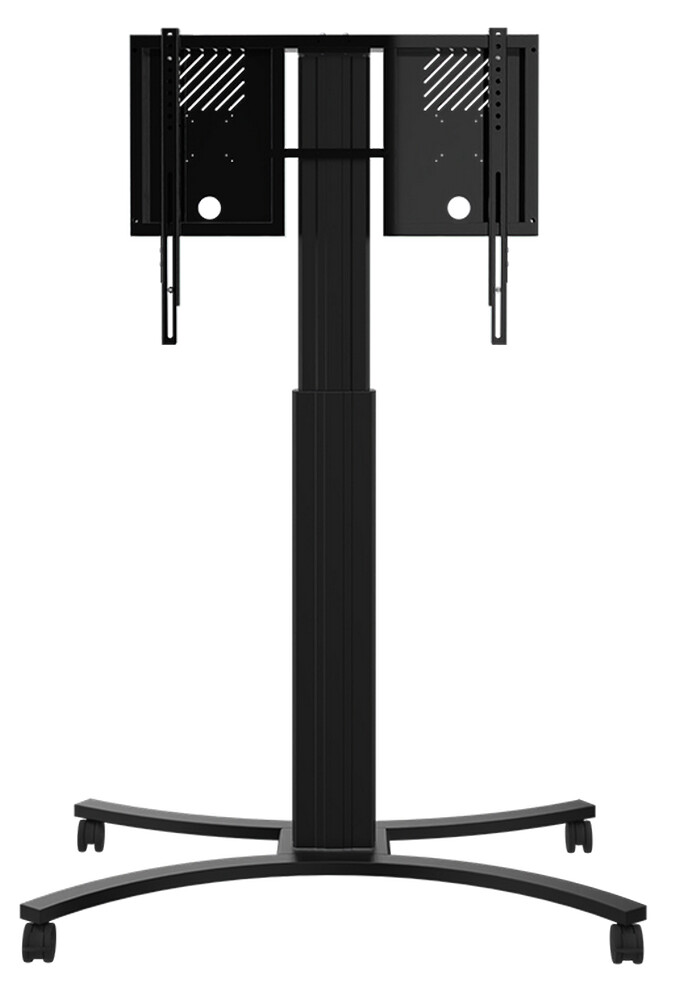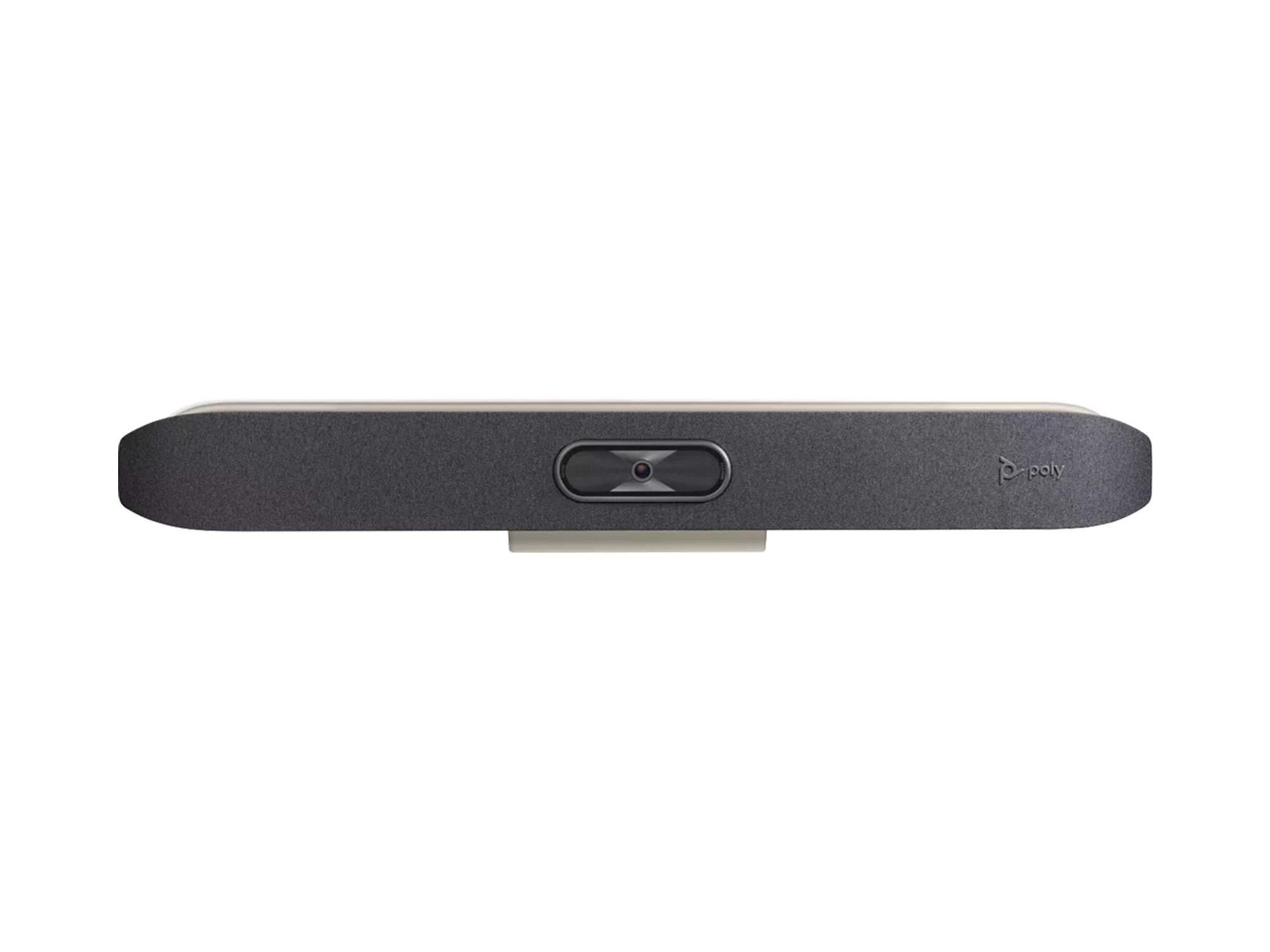



















£8,692.82*
- Resolution 3840 x 2160 4K UHD
- Aspect Ratio 16:9
- Max. Brightness 300 cd/m²


Frequently purchased together
Product information
DTEN D7X: A comprehensive solution for modern work environments
The advanced technology of the Artificial Intelligence-powered DTEN D7X revolutionises the way meeting rooms are used by transforming them into modern, technologically advanced workspaces. With its sophisticated technology and versatile design, the DTEN D7X offers an all-in-one solution to meet the needs of any corporate environment.

What makes DTEN D7X unique is its extensive compatibility with leading communication platforms. The DTEN D7X is not only a certified device for Zoom Rooms, but also an approved solution for Microsoft Teams. This enables seamless and efficient sharing of information, regardless of the platform chosen. This all-in-one device not only simplifies collaboration and communication, but also increases productivity through its user-friendly features. The promise of DTEN D7X is to increase meeting efficiency while creating a modern, interactive work environment.
Experience the following highlights:
- 4K multi-touch display
- 20 touch points / Low latency - 50 ms response time
- KI-based to improve touch accuracy
- Integrated 4K camera with 120° field of view
- Built-in microphone array and speaker
The pinnacle of conference room technology
The DTEN D7X is not just a simple video conferencing device, but embodies the most advanced technology in conference room solutions. With a strong focus on Deep Learning and Artificial Intelligence, combined with enhanced computing capabilities, the DTEN D7X represents a significant innovation in the digital workplace.

This state-of-the-art solution offers a range of industry-leading, innovative features that help transform the DTEN D7X from a traditional video conferencing device into the most modern, technologically advanced all-in-one meeting room solution. From automatic software updates to intelligent audio technologies and advanced screen sharing options, the DTEN D7X has everything you need for a productive and efficient meeting.
The DTEN D7X is available in two operating system versions: a Windows edition and an Android edition. This gives it greater choice and flexibility for different work environments and requirements. In addition, users can choose between two screen sizes - a 55-inch display for smaller rooms and an impressive 75-inch display for larger gatherings. With these options, the DTEN D7X seamlessly adapts to the specific needs and preferences of any organisation.
A versatile, enterprise-ready solution for multiple platforms
In today's fast-paced digital world, the DTEN D7X has created a revolutionary solution that is both flexible and enterprise-ready. This multi-platform solution allows users to bring their own device (BYOD) and seamlessly integrate it into the DTEN D7X system.

Whether you're hosting a Zoom meeting, attending a Microsoft Teams meeting or virtually any other video conference, the DTEN D7X makes it easy to connect your laptop with a single USB-C charging cable. This simple connectivity provides a straightforward and efficient way to ensure a professional meeting experience.
Experience the difference: premium audio quality with the DTEN D7X
The DTEN D7X is equipped with a range of premium audio features that help you focus fully on your meetings instead of being distracted by distracting background noise. With enhanced audio optimisation powered by artificial intelligence, the DTEN D7X effectively suppresses distracting ambient noise for a clearer and more focused meeting experience.

The speakers of the DTEN D7X have been further improved and are now four times more powerful than their predecessors. This ensures that every participant, even in larger rooms, can hear the discussions clearly. This improvement is a crucial factor in ensuring that no important information is missed and that every participant can actively participate in the meeting.
Experience enhanced visual communication with the DTEN D7X
With the DTEN D7X, you can experience visual elements of your meetings like never before and realise what you have been missing. The DTEN D7X offers an impressive 20% improvement in video quality so that every participant can be seen clearly. This is a game-changer in visual communication that will drive interaction and engagement in your meetings.

Artificial Intelligence supports the DTEN D7X's 4K extra-wide-angle camera, which offers a 129-degree viewing angle. This allows everyone in the room to be captured, even those who tend to be on the periphery. This provides an inclusive meeting experience where all participants are equal, regardless of where they are in the room.
Take your collaboration to a new level with the DTEN D7X
The DTEN D7X gives you enhanced collaboration capabilities by using advanced technologies to provide a more intuitive and efficient meeting experience. With its AI-powered 4K touchscreen technology, you can capture inspiration instantly and work in real time with whiteboarding and annotation features. This is a great way to visualise, share and collaborate on ideas.

The natural writing tools, automatic shapes and a choice of colours allow users to represent their thoughts and ideas in a natural and intuitive way. This encourages creativity and collaboration by allowing users to articulate their thoughts in a clear and visually appealing way.
Simplified connectivity for a seamless meeting experience
The DTEN D7X has redefined connectivity by providing a simple and efficient way to integrate your laptop into the meeting system. With this streamlined solution, you'll never have to bring your laptop charging cable to a meeting again. You can easily connect your device to the system via a single USB-C 65W charging cable that serves as both power and Bring Your Own Device (BYOD) integration.

This simple networking allows users to quickly and effortlessly access and integrate their personal devices into the meeting system, ensuring a smooth and efficient meeting experience. This saves valuable time and ensures that participants can focus on the meeting instead of dealing with technical details.
Technical data
| Name | DTEN D7X Windows Edition 75" Touch display |
|---|---|
| Article number | 1000028457 |
| GTIN/EAN | 0850027314273 |
| Manufacturer SKU | DB71475E |
| Model name | D7X Windows Edition |
| variant | Single Display Windows Edition |
| Brand | DTEN |
| Product Type | Touch display |
| Technology | LED Technology LED: LED is a lighting technology. With LED technology, diodes are used as illuminants and not conventional UHP lamps. The advantage of this technology is that the diodes do not use a filament and practically do not consume energy. However, LEDs have a more bluish colour range than UHP lamps, which is why the image is often perceived as somewhat colder. Colour wheel: Besides the DMD chip, the colour wheel is one of the most important criteria for image generation in DLP projectors. The colour wheel rotates constantly at extremely high speed and currently has 3, 4, 5 or, in some cases, even more colour segments. Through the colour wheel, the light from the projector lamp is alternately broken down into the primary colours red, green and blue practically without interruption. In modern projectors, the colour wheel also contains white and sometimes other colours such as cyan, magenta and yellow. With 3 segments, the colour wheel rotates at 3600 or 7200 rpm, with 7 segments at up to 14400 rpm. (4x speed). Each colour perceived by the eye in a DLP projector is therefore an extremely fast sequence of individual, differently coloured light beams until the actual processing. Because this technology sometimes does not use all the colour positions of the colour wheel for high-contrast images, or because the colours required for colour mixing are arranged far apart on the wheel, some viewers recognise the rainbow effect. This characteristic is more noticeable with slower colour wheels and slower rotation speeds than with projectors with faster and more frequently segmented colour wheels. |
| Resolution | 3840 x 2160 4K UHD Resolution Resolution: The resolution of a projector is the maximum number of image points (pixels) that a projector can display based on its naturally existing technology, i.e. without conversion or cropping of the image. The native resolution is the number of pixels that a projector physically has to display the image. A projector usually interpolates a resolution when it receives an image signal with a higher resolution than the native one. If this is the case, there may be a lack of image detail or general blurring in the displayed image. If a projector receives an image signal with a lower resolution than the native, it also interpolates, it scales the image up to the native resolution, calculates corresponding additional pixels, if possible without changing the image information. The disadvantage here is that although the image is displayed larger than fed, the original individual pixels may become much more visible as they are multiplied by the conversion. 4K: 4K refers to the resolution of 3840 x 2160 or Ultra High Definition Television (UHDTV). This resolution corresponds to 4 times the resolution of Full HD. To record films with this resolution, special cameras are needed that can record at around 8 megapixels (4K). Full HD: The term Full HD is used to describe devices that can physically display or output HDTV signals in full (1920 x 1080 pixels). 1080p: 1080p is the specification of the vertical picture lines. Among other things, it refers to the resolution 1920 x 1080. The "p" in this case means full frames, so all picture lines are displayed simultaneously. 1080i: 1080i is the specification of the vertical picture lines. The "i" in this case means fields. This signal is usually displayed interpolated (e.g. by devices with a 1280 x 720 HDready resolution). The interpolation digitally adds pixels, but also offers a slight blurring. In contrast, 1080p playback uses full frames. |
| Diagonal | 75" |
| Aspect Ratio | 16:9 Aspect Ratio Format: The projected image is output in a format (aspect ratio) specified by the projector. The format is also determined by the resolution of the projector (see also the entry "Resolution"). The screen format is usually selected on the basis of the format of the beamer image. The most common formats are 4:3, 16:9 and 16:10. |
| Viewing angle - Horizontal | 178° Viewing angle - Horizontal Viewing angle: The viewing angle indicates the distance from the centre line at which the projected image is perceived as being of good quality without restrictions. As a rule, the horizontal viewing angle is specified. A good viewing angle lies within a range of 110 to 130 degrees from the centre of the picture, i.e. 55 to 65 degrees to the left and 65 to the right. If you are outside the viewing angle, the picture deteriorates disproportionately. |
| Viewing angle - Vertical | 178° Viewing angle - Vertical Viewing angle: The viewing angle indicates the distance from the centre line at which the projected image is perceived as being of good quality without restrictions. As a rule, the horizontal viewing angle is specified. A good viewing angle lies within a range of 110 to 130 degrees from the centre of the picture, i.e. 55 to 65 degrees to the left and 65 to the right. If you are outside the viewing angle, the picture deteriorates disproportionately. |
| Max. Brightness | 300 cd/m² |
| Response time | 50ms |
| Support - VESA | 800 x 400 |
| Inputs | 1x 3,5mm Jack , 1x Ethernet , 1x HDMI , 4x USB-A Inputs HDMI: Digital connection for the transmission of picture & sound. Necessary for high-resolution picture quality (HDTV). Since HDMI 1.4 (High Speed) suitable for transmission of 3D content in Full HD. For high-resolution picture quality in UHD, 4K or HDR, the connection via HDMI 2.0a and higher is suitable. HDMI 2.1 or higher should be used from 120Hz refresh rate in 4K. VGA: The VGA connector is a 15-pin connector for analogue image transmission. It is also called DSub15 and is often found on notebooks and PCs. Compared to the other analogue connections, it offers good picture quality. It can be screwed to the input or output device and can be adapted to YUV with a suitable configuration. DisplayPort: The DisplayPort connection is a VESA-standardised connection for the transmission of image and sound data. In addition to HDCP encryption, DPCP is also supported. Due to its compact size, the connection is most commonly used in notebooks. An extra small variant is the MiniDisplayPort, which is used especially with Apple devices. DVI: DVI (Digital Visual Interface) is an interface for the transmission of video data. Only analogue signals can be transmitted via DVi-A, only digital signals via DVI-D and both types of signals via DVI-I. USB: USB (Universal Serial Bus) is used to control and manage the projector (USB-B). With some business devices, office files and images can also be presented directly with a USB stick or a mouse can be connected via the USB input (USB-A). Toslink: The Toslink connection is an optical signal connection that works on an optical fibre basis. It is used for the digital transmission of audio signals. The optical design offers a lower susceptibility to interference from external magnetic and electrical influences. The connection is mostly used in the area of DVD / Blu-ray players and comparable devices in connection with an AV receiver, if these work with dts or Dolby Digital signals. YUV: The YUV connection, also called Y Cb/Pb Cr/Pr or component connection, is an analogue video connection with three channels (light intensity and two colour channels). Qualitatively, it is the best analogue video connection. Component cable: The YUV connector transmits analogue signals over three cables (Y=black and white UV=colours). YUV is used to transmit HDTV and is compatible with Cinch, for example. S-Video: The S-Video connection is also called S-VHS or Hosiden connection. Compared to the Cinch video connection, it works with two channels (brightness/colour). In terms of quality, it is somewhat better than the Cinch video connection, but there are also limitations. These can be explained by the susceptibility of the signal, which is reflected in picture distortions, for example. Cinch: The cinch video connection is also called composite connection. To make it easier to recognise, it is usually sheathed in yellow. Since the transmission is only via one channel, the picture quality is on a low level. D-Sub15: The VGA connector is a 15-pin connector for image transmission on an analogue basis. It is also called DSub15 and is often found on notebooks and PCs. Compared to the other analogue connectors, it offers good picture quality. It can be screwed to the input or output device and can be adapted to YUV with a suitable configuration. RS232: The RS232 interface can be used to control or manage the projector. Mini Jack: With a single-pin Mini Jack, mono audio signals can be transmitted, with a two-pin stereo audio signals and with a three-pin stereo audio signals and image data can be transmitted. Scart: Scart is a connector that can be used to transmit analogue audio and video signals. It is compatible with other analogue connections such as RCA or S-Video. ARC: The audio return channel, also called ARC or audio return channel, was introduced with HDMI version 1.4 to reduce the amount of cabling between HDMI components. The audio return channel runs via the existing HDMI cable. Therefore, an additional cable for the sound no longer needs to be connected. However, both devices must support ARC. All audio file formats that are also transmitted via the SPDIF interface can be transmitted via the audio return channel. These include Dolby Digital, Digital Theatre Sound and PCM audio. As an example, a connection between a TV (including receiver) and an AV receiver could be made via an HDMI cable. The sound from the TV is fed back via the HDMI cable. Previously, an additional digital cable (coaxial or Tos-Link) was required for the audio signals. |
| Outputs | 1x HDMI Outputs HDMI: Digital connection for the transmission of picture & sound. Necessary for high-resolution picture quality (HDTV). Since HDMI 1.4 (High Speed) suitable for transmission of 3D content in Full HD. For high-resolution picture quality in UHD, 4K or HDR, the connection via HDMI 2.0a and higher is suitable. HDMI 2.1 or higher should be used from 120Hz refresh rate in 4K. VGA: The VGA connector is a 15-pin connector for analogue image transmission. It is also called DSub15 and is often found on notebooks and PCs. Compared to the other analogue connections, it offers good picture quality. It can be screwed to the input or output device and can be adapted to YUV with a suitable configuration. DisplayPort: The DisplayPort connection is a VESA-standardised connection for the transmission of image and sound data. In addition to HDCP encryption, DPCP is also supported. Due to its compact size, the connection is most commonly used in notebooks. An extra small variant is the MiniDisplayPort, which is used especially with Apple devices. DVI: DVI (Digital Visual Interface) is an interface for the transmission of video data. Only analogue signals can be transmitted via DVi-A, only digital signals via DVI-D and both types of signals via DVI-I. USB: USB (Universal Serial Bus) is used to control and manage the projector (USB-B). With some business devices, office files and images can also be presented directly with a USB stick or a mouse can be connected via the USB input (USB-A). Toslink: The Toslink connection is an optical signal connection that works on an optical fibre basis. It is used for the digital transmission of audio signals. The optical design offers a lower susceptibility to interference from external magnetic and electrical influences. The connection is mostly used in the area of DVD / Blu-ray players and comparable devices in connection with an AV receiver, if these work with dts or Dolby Digital signals. YUV: The YUV connection, also called Y Cb/Pb Cr/Pr or component connection, is an analogue video connection with three channels (light intensity and two colour channels). Qualitatively, it is the best analogue video connection. Component cable: The YUV connector transmits analogue signals over three cables (Y=black and white UV=colours). YUV is used to transmit HDTV and is compatible with Cinch, for example. S-Video: The S-Video connection is also called S-VHS or Hosiden connection. Compared to the Cinch video connection, it works with two channels (brightness/colour). In terms of quality, it is somewhat better than the Cinch video connection, but there are also limitations. These can be explained by the susceptibility of the signal, which is reflected in picture distortions, for example. Cinch: The cinch video connection is also called composite connection. To make it easier to recognise, it is usually sheathed in yellow. Since the transmission is only via one channel, the picture quality is on a low level. D-Sub15: The VGA connector is a 15-pin connector for image transmission on an analogue basis. It is also called DSub15 and is often found on notebooks and PCs. Compared to the other analogue connectors, it offers good picture quality. It can be screwed to the input or output device and can be adapted to YUV with a suitable configuration. RS232: The RS232 interface can be used to control or manage the projector. Mini Jack: With a single-pin Mini Jack, mono audio signals can be transmitted, with a two-pin stereo audio signals and with a three-pin stereo audio signals and image data can be transmitted. Scart: Scart is a connector that can be used to transmit analogue audio and video signals. It is compatible with other analogue connections such as RCA or S-Video. ARC: The audio return channel, also called ARC or audio return channel, was introduced with HDMI version 1.4 to reduce the amount of cabling between HDMI components. The audio return channel runs via the existing HDMI cable. Therefore, an additional cable for the sound no longer needs to be connected. However, both devices must support ARC. All audio file formats that are also transmitted via the SPDIF interface can be transmitted via the audio return channel. These include Dolby Digital, Digital Theatre Sound and PCM audio. As an example, a connection between a TV (including receiver) and an AV receiver could be made via an HDMI cable. The sound from the TV is fed back via the HDMI cable. Previously, an additional digital cable (coaxial or Tos-Link) was required for the audio signals. |
| wireless technology | Bluetooth , WiFi wireless technology WLAN: WLAN (Wireless Local Area Network) refers to a wireless network. For example, projectors or displays can be connected wirelessly to various sources (notebooks, smartphones, etc.) to realise wireless image transmission. In some cases, additional components (dongles/adapters) are required for this if a wireless connection is not directly supported. AirPlay: Apple's AirPlay technology is used for wireless transmission of content, such as music and videos, from iOS and Mac devices. These can also be receiver devices such as speakers, AV receivers and stereo systems or TVs. Streaming also works from an iOS device to a matching receiver. The protocol developed by Apple can also be licensed by other manufacturers. iProjection: With the free Epson iProjection app, projectors can be operated remotely and office content and photos can be projected. The app is compatible with current Epson business projectors and can also be used as a practical remote control. Other features of this functionality include searching for available projectors, volume control, mute, and a freeze function to freeze the current image of a presentation. The most important Office contents, such as Word, Excel, PowerPoint, Keynote and PDF files, are supported and can be played back directly from the medium. Images in JPEG and PNG format can also be presented directly. The Epson iProjection app is available for download free of charge from the Apple App Store and the google Play Store. Easy MP: A special network function from Epson. The Easy MP function allows you to present efficiently over multiple computers via an existing network. Easy MP allows you to transfer a presentation, images as well as audio data via the network and thus receive a selection from various sources in the network. |
| Features | Touch screen |
| Product width | 167.9 cm |
| Product height | 100.4 cm |
| Product depth | 5.54 cm |
| Weight | 36.1 kg |
| Colour | Grey |
| EEK Spectrum | A to G |
| Delivery contents | Power cable , Quick user guide , USB-C Cable , mount |
| Condition | New |
| Warranty | 24 Month |
| Warranty type | Bringin service Service and support information |
Manufacturer's warranty information:
Here you will find more detailed information on the different types of warranty. Please refer to our manufacturer overview for contact details and warranty conditions for the corresponding warranty claim. Statutory warranty rights are not restricted by an additional manufacturer's warranty. Our liability for defects is governed by law. Defect rights can be claimed free of charge.


















